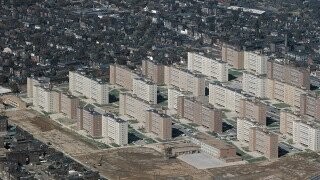America's Dystopian '50s Housing Now Looks Utopian

We gave readers $50 billion in imaginary money and challenged them to build something great. There was a surprising amount of consensus on the best thing to make. "Affordable housing," said April P. "Every single city in the US would get a massive apartment building for homeless people," said Colleen D. Chuck P. went extra specific: "Low income hempcrete housing buildings with solar panels and wind turbines, water collection with reverse osmosis perfection."
Julie H. focused on existing housing as a foundation, saying, "I buy and renovate every uninhabited house and abandoned building in the country and then give them all away. Let the landlords starve." Bitterness against the rich is absolutely a valid motive, which is why Brian P. said he wants to put his housing for the poor "specifically in neighborhoods that don't want them there."
You've convinced us: This is a great answer. But when you tell this to other people, prepare to defend yourselves when they mention the following as a counter-argument: "Pruitt–Igoe."
Don't Miss
St. Louis's Pruitt–Igoe housing projects, built in the '50s and torn down two decades later, were for a long time a punchline, a famous example of how public housing can go wrong. As you can see in the picture above, the 33 eleven-story towers didn't exactly blend into the typical American city. They look more like those terrifying blocks that China builds. That ugliness, if it’s a dealbreaker, isn't inherently a part of public housing, however. The architect, Minoru Yamasaki, designed something less awful, but then the city slashed the project budget.
Other unique factors doomed Pruitt–Igoe. It started out racially segregated, which was bad of course, and when desegregation kicked in, white residents fled instead of mixing. In 1950, St. Louis was one of the biggest cities in the country, and they expected the project would cater to huge population growth in the years to come. Instead, unlike nearly every other city, St. Louis proper saw its population fall—it fell hard from 1950 to 1970, and it continued to fall ever since.
So, lots of the buildings became vacant, the city stopped maintaining them, and gangs took over. The city demolished the buildings over the course of a few years in the '70s, televising some of the destruction so everyone at least got a good show out of it. Still, the idea of thousands of units crowded into dozens of acres isn't bad. Today, lots of prospective tenants want just that and are furious that regulations keep any from getting built.
As for the architect, Minoru Yamasaki, he wasn't exactly banished as a failure. Later in the '70s, another of his plans became reality: New York's World Trade Center.
This fact came from the One Cracked Fact newsletter. Want more like this, straight from your email inbox, without any ads or popups? Join here:
For more building stories, check out:
4 Buildings That Defy the Laws of Gravity
Follow Ryan Menezes on Twitter for more stuff no one should see.
Top image: USGS
